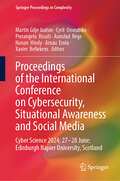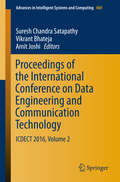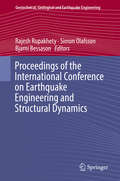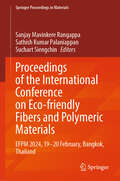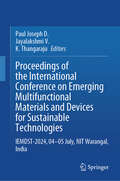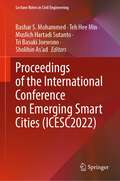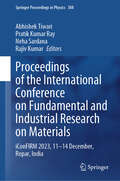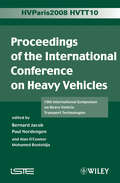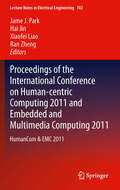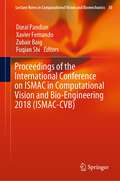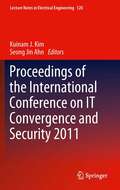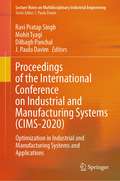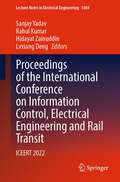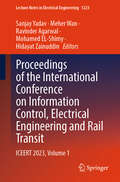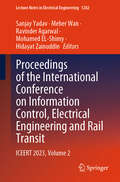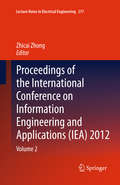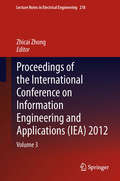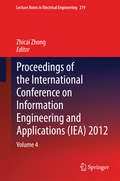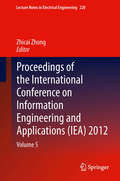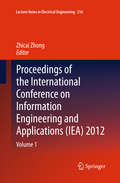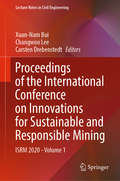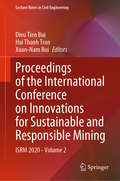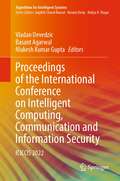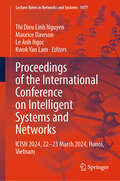- Table View
- List View
Proceedings of the International Conference on Cybersecurity, Situational Awareness and Social Media: Cyber Science 2023; 03–04 July; University of Aalborg, Copenhagen, Denmark (Springer Proceedings in Complexity)
by Pierangelo Rosati Martin Gilje Jaatun Cyril Onwubiko Aunshul Rege Arnau Erola Xavier Bellekens Hanan HindyThis book highlights advances in cyber security, cyber situational awareness (CyberSA), artificial intelligence (AI) and social media. It brings together original discussions, ideas, concepts and outcomes from research and innovation from multidisciplinary experts. It offers topical, timely and emerging original innovations and research results in cyber situational awareness, security analytics, cyber physical systems, blockchain technologies, machine learning, social media and wearables, protection of online digital service, cyber incident response, containment, control and countermeasures (CIRC3). The theme of Cyber Science 2023 is multidisciplinary and multidimensional cyber security. And through call for papers, we solicit original contributions advancing research in artificial intelligence, machine learning, blockchain, cyber security, social media, cyber incident response and cyber insurance.
Proceedings of the International Conference on Cybersecurity, Situational Awareness and Social Media: Cyber Science 2024; 27–28 June; Edinburgh Napier University, Scotland (Springer Proceedings in Complexity)
by Pierangelo Rosati Martin Gilje Jaatun Cyril Onwubiko Aunshul Rege Arnau Erola Xavier Bellekens Hanan HindyThis book presents peer-reviewed articles from Cyber Science 2024, held on 27–28 June at Edinburgh Napier University in Scotland. With no competing conferences in this unique and specialized area (cyber science), especially focusing on the application of situation awareness to cyber security (CS), artificial intelligence, blockchain technologies, cyber physical systems (CPS), social media and cyber incident response, it presents a fusion of these unique and multidisciplinary areas into one that serves a wider audience making this conference a sought-after event. Hence, this proceedings offers a cutting edge and fast reaching forum for organizations to learn, network, and promote their services. Also, it offers professionals, students, and practitioners a platform to learn new and emerging disciplines.
Proceedings of the International Conference on Data Engineering and Communication Technology
by Suresh Chandra Satapathy Vikrant Bhateja Amit JoshiThis two-volume book contains research work presented at the First International Conference on Data Engineering and Communication Technology (ICDECT) held during March 10-11, 2016 at Lavasa, Pune, Maharashtra, India. The book discusses recent research technologies and applications in the field of Computer Science, Electrical and Electronics Engineering. The aim of the Proceedings is to provide cutting-edge developments taking place in the field data engineering and communication technologies which will assist the researchers and practitioners from both academia as well as industry to advance their field of study.
Proceedings of the International Conference on Earthquake Engineering and Structural Dynamics (Geotechnical, Geological and Earthquake Engineering #47)
by Rajesh Rupakhety Simon Olafsson Bjarni BessasonThis book includes a collection of chapters that were presented at the International Conference on Earthquake Engineering and Structural Dynamics (ICESD), held in Reykjavik, Iceland between 12-14 June 2017. The contributions address a wide spectrum of subjects related to wind engineering, earthquake engineering, and structural dynamics. Dynamic behavior of ultra long span bridges that are discussed in this volume represent one of the most challenging and ambitious contemporary engineering projects. Concepts, principles, and applications of earthquake engineering are presented in chapters addressing various aspects such as ground motion modelling, hazard analysis, structural analysis and identification, design and detailing of structures, risk due to non-structural components, and risk communication and mitigation. The presented chapters represent the state-of-the-art in these fields as well as the most recent developments.
Proceedings of the International Conference on Eco-friendly Fibers and Polymeric Materials: EFPM 2024, 19–20 February, Bangkok, Thailand (Springer Proceedings in Materials #60)
by Suchart Siengchin Sanjay Mavinkere Rangappa Sathish Kumar PalaniappanThis proceedings book contains papers presented at the International Conference on Eco-friendly Fibers and Polymeric Materials (LSPM23) held on EFPM 2024, 19–20 February, Bangkok, Thailand. The papers in this book are presented by academics and industrial practitioners showcasing the latest technological advancements and applications of environmentally friendly polymeric materials with an emphasis on the production of bio-based fibers and polymers are greatly enlarging its range of applications in different industrial sectors including automobiles, sports, architecture, design, and many others. The content of this book appeals to academia and industrial researchers from the fields of polymer chemistry, physics, and materials science.
Proceedings of the International Conference on Emerging Multifunctional Materials and Devices for Sustainable Technologies: IEMDST-2024, 04-05 July, NIT Warangal, India
by Paul Joseph D. Jayalakshmi V. K. ThangarajuThis book includes peer reviewed articles from IEMDST-2024, held on 04-05 July at NIT Warangal in India. The motivation behind the International Conference on Emerging Multifunctional Materials and Devices for Sustainable Technologies (IEMDST-2024) is to address and highlight the critical role of advanced materials and devices in the pursuit of sustainable technologies. The conference is organized by the Department of Physics at the National Institute of Technology, Warangal, in collaboration with the Department of Applied Sciences of NIT Goa. It serves as a catalyst for the exchange of knowledge and ideas among researchers and professionals from various fields related to materials science and technology.
Proceedings of the International Conference on Emerging Smart Cities (Lecture Notes in Civil Engineering #324)
by Bashar S. Mohammed Teh Hee Min Muslich Hartadi Sutanto Tri Basuki Joewono Sholihin As’adThis book contains papers presented at the International Conference on Emerging Smart Cities (ICESC2022), previously known as the International Conference on Civil, Offshore and Environmental Engineering (ICCOEE). ICESC is held under the banner of World Engineering, Science and Technology Congress (ESTCON2022) from 1 to2 December 2022 at Borneo Convention Centre, Kuching, Sarawak, Malaysia. This proceeding contains papers presented by academics and industrial practitioners showcasing the latest advancements and findings in civil engineering areas with an emphasis on emerging smart cities for the ultimate shape of urban living in the near future. The papers are categorized under the following tracks: (1) Climate Adaptive materials; (2) Environmental sustainability; (3) Infrastructure efficiency.
Proceedings of the International Conference on Fundamental and Industrial Research on Materials: iConFIRM 2023, 11−14 December, Ropar, India (Springer Proceedings in Physics #308)
by Rajiv Kumar Abhishek Tiwari Pratik Kumar Ray Neha SardanaThis book presents peer reviewed articles from the International Conference on Fundamental and Industrial Research on Materials- iConFIRM 2023; held from 11th to 14th Dec at Ropar in India. It includes recent advances in the area of mechanics of metallic, nano and energy materials, extractive metallurgy, and processing. Fundamental research works including development and characterization of new alloys, ceramics, composites and nano materials along with advanced characterization techniques such as XRD, SEM and TEM and mathematical modelling, finite element simulations, molecular dynamics, machine learning and similar other advanced numerical, theoretical and experimental techniques in the field of materials and metallurgy.
Proceedings of the International Conference on Heavy Vehicles, HVTT10: 10th International Symposium on Heavy Vehicle Transportation Technologies
by Paul Nordengen Mohamed Bouteldja Bernard Jacob Alan O’ConnorThis reference collects the latest information from the International Conference on Heavy Vehicles, specifically as it relates to Heavy Vehicle Transport Technology. Among the topics detailed are: interactions between heavy vehicles or trains and the infrastructure, environment and other system users; heavy vehicle and road management information-measurements, data quality, data management; freight mobility and safety; vehicle classification, size and weight evaluation, regulations, and enforcement; and traffic and road safety.
Proceedings of the International Conference on Human-centric Computing 2011 and Embedded and Multimedia Computing 2011
by Hai Jin Xiaofei Liao James J. Park Ran ZhengProceedings of the International Conference on Human-centric Computing and Embedded and Multimedia Computing (HumanCom & EMC 2011) will cover topics of HumanCom and EMC, the current hot topics satisfying the world-wide ever-changing needs. Human-centric computing is to create novel solutions so that the humans are always connected, portable, and available. As with pervasive-computing, human-centric computing requires a variety of devices; however, such devices exist simply to obtain inputs from the human and are embedded in objects that humans interact with on a daily basis. Moreover, during the past couple of decades, Information Science technologies influenced and changed every aspect of our lives and our cultures. Without various Information Science technology-based applications, it would be difficult to keep information stored securely, to process information efficiently, and to communicate conveniently. Embedded computing ranges from portable devices such as digital watches and MP3 players, to large stationary installations like traffic lights, factory controllers, or the systems controlling nuclear power plants. Complexity varies from low, with a single microcontroller chip, to very high with multiple units, peripherals and networks mounted inside a large chassis or enclosure. Multimedia computing covers multimedia I/O devices, OS, storage systems, streaming media middleware, continuous media representations, media coding, media processing, etc., and also includes multimedia communications; real-time protocols, end-to-end streaming media, resource allocation, multicast protocols, and multimedia applications; databases, distributed collaboration, video conferencing, 3D virtual environments.
Proceedings of the International Conference on ISMAC in Computational Vision and Bio-Engineering 2018 (Lecture Notes in Computational Vision and Biomechanics #30)
by Xavier Fernando Durai Pandian Zubair Baig Fuqian ShiThese are the proceedings of the International Conference on ISMAC-CVB, held in Palladam, India, in May 2018. The book focuses on research to design new analysis paradigms and computational solutions for quantification of information provided by object recognition, scene understanding of computer vision and different algorithms like convolutional neural networks to allow computers to recognize and detect objects in images with unprecedented accuracy and to even understand the relationships between them. <P><P>The proceedings treat the convergence of ISMAC in Computational Vision and Bioengineering technology and includes ideas and techniques like 3D sensing, human visual perception, scene understanding, human motion detection and analysis, visualization and graphical data presentation and a very wide range of sensor modalities in terms of surveillance, wearable applications, home automation etc. <P><P>ISMAC-CVB is a forum for leading academic scientists, researchers and research scholars to exchange and share their experiences and research results about all aspects of computational vision and bioengineering.
Proceedings of the International Conference on IT Convergence and Security 2011
by Kuinam J. Kim Seong Jin AhnAs we entered the 21st century, the rapid growth of information technology has changed our lives more conveniently than we have ever speculated. Recently in all fields of the industry, heterogeneous technologies have converged with information technology resulting in a new paradigm, information technology convergence. In the process of information technology convergence, the latest issues in the structure of data, system, network, and infrastructure have become the most challenging task. Proceedings of the International Conference on IT Convergence and Security 2011 approaches the subject matter with problems in technical convergence and convergences of security technology by looking at new issues that arise from techniques converging. The general scope is convergence security and the latest information technology with the following most important features and benefits: 1. Introduction of the most recent information technology and its related ideas 2. Applications and problems related to technology convergence, and its case studies 3. Introduction of converging existing security techniques through convergence security Overall, after reading Proceedings of the International Conference on IT Convergence and Security 2011, readers will understand the most state of the art information strategies and technologies of convergence security.
Proceedings of the International Conference on Industrial and Manufacturing Systems: Optimization in Industrial and Manufacturing Systems and Applications (Lecture Notes on Multidisciplinary Industrial Engineering)
by J. Paulo Davim Mohit Tyagi Dilbagh Panchal Ravi Pratap SinghIn order to deal with the societal challenges novel technology plays an important role. For the advancement of technology, Department of Industrial and Production Engineering under the aegis of NIT Jalandhar is organizing an “International Conference on Industrial and Manufacturing Systems” (CIMS-2020) from 26th -28th June, 2020. The present conference aims at providing a leading forum for sharing original research contributions and real-world developments in the field of Industrial and Manufacturing Systems so as to contribute its share for technological advancements. This volume encloses various manuscripts having its roots in the core of industrial and production engineering. Globalization provides all around development and this development is impossible without technological contributions. CIMS-2020, gathered the spirits of various academicians, researchers, scientists and practitioners, answering the vivid issues related to optimisation in the various problems of industrial and manufacturing systems.
Proceedings of the International Conference on Information Control, Electrical Engineering and Rail Transit: ICEERT 2022 (Lecture Notes in Electrical Engineering #1084)
by Rahul Kumar Sanjay Yadav Hidayat Zainuddin Lvxiang DengThis book includes the peer-reviewed proceedings of the 2nd International Conference on Information Control, Electrical Engineering, and Rail Transit (ICEERT 2022). This book provides the advanced research results of transportation and covers the main research fields of information control, traffic information engineering, and control, intelligent transit, logistics, etc. This book aims to promote a new green and intelligent mode of rail transit between scholars from the top universities, research centers, and high-tech enterprises around the world, which is beneficial to researchers and practitioners in mechanical engineering.
Proceedings of the International Conference on Information Control, Electrical Engineering and Rail Transit: ICEERT 2023, Volume 1 (Lecture Notes in Electrical Engineering #1223)
by Sanjay Yadav Meher Wan Hidayat Zainuddin Ravinder Agarwal Mohamed El-ShimyThis book includes the peer-reviewed proceedings of the 3rd International Conference on Information Control, Electrical Engineering, and Rail Transit (ICEERT 2023). This book provides the advanced research results of transportation and covers the main research fields of information control, traffic information engineering, and control, intelligent transit, logistics, etc. This book aims to promote a new green and intelligent mode of rail transit between scholars from the top universities, research centers, and high-tech enterprises around the world, which is beneficial to researchers and practitioners in mechanical engineering.
Proceedings of the International Conference on Information Control, Electrical Engineering and Rail Transit: ICEERT 2023, Volume 2 (Lecture Notes in Electrical Engineering #1282)
by Sanjay Yadav Meher Wan Hidayat Zainuddin Ravinder Agarwal Mohamed El-ShimyThis book includes the peer-reviewed proceedings of the 3rd International Conference on Information Control, Electrical Engineering, and Rail Transit (ICEERT 2023). This book provides the advanced research results of transportation and covers the main research fields of information control, traffic information engineering, and control, intelligent transit, logistics, etc. This book aims to promote a new green and intelligent mode of rail transit between scholars from the top universities, research centers, and high-tech enterprises around the world, which is beneficial to researchers and practitioners in mechanical engineering.
Proceedings of the International Conference on Information Engineering and Applications (IEA) 2012: 217
by Zhicai ZhongInformation engineering and applications is the field of study concerned with constructing information computing, intelligent systems, mathematical models, numerical solution techniques, and using computers and other electronic devices to analyze and solve natural scientific, social scientific and engineering problems. <P><P> Information engineering is an important underpinning for techniques used in information and computational science and there are many unresolved problems worth studying. The Proceedings of the 2nd International Conference on Information Engineering and Applications (IEA 2012), which was held in Chongqing, China, from October 26-28, 2012, discusses the most innovative research and developments including technical challenges and social, legal, political, and economic issues.<P> A forum for engineers and scientists in academia, industry, and government, the Proceedings of the 2nd International Conference on Information Engineering and Applications presents ideas, results, works in progress, and experience in all aspects of information engineering and applications.
Proceedings of the International Conference on Information Engineering and Applications (IEA) 2012: 218
by Zhicai ZhongInformation engineering and applications is the field of study concerned with constructing information computing, intelligent systems, mathematical models, numerical solution techniques, and using computers and other electronic devices to analyze and solve natural scientific, social scientific and engineering problems. <P><P> Information engineering is an important underpinning for techniques used in information and computational science and there are many unresolved problems worth studying. The Proceedings of the 2nd International Conference on Information Engineering and Applications (IEA 2012), which was held in Chongqing, China, from October 26-28, 2012, discusses the most innovative research and developments including technical challenges and social, legal, political, and economic issues.<P> A forum for engineers and scientists in academia, industry, and government, the Proceedings of the 2nd International Conference on Information Engineering and Applications presents ideas, results, works in progress, and experience in all aspects of information engineering and applications.
Proceedings of the International Conference on Information Engineering and Applications (IEA) 2012: 219
by Zhicai ZhongInformation engineering and applications is the field of study concerned with constructing information computing, intelligent systems, mathematical models, numerical solution techniques, and using computers and other electronic devices to analyze and solve natural scientific, social scientific and engineering problems. <P><P> Information engineering is an important underpinning for techniques used in information and computational science and there are many unresolved problems worth studying. The Proceedings of the 2nd International Conference on Information Engineering and Applications (IEA 2012), which was held in Chongqing, China, from October 26-28, 2012, discusses the most innovative research and developments including technical challenges and social, legal, political, and economic issues.<P> A forum for engineers and scientists in academia, industry, and government, the Proceedings of the 2nd International Conference on Information Engineering and Applications presents ideas, results, works in progress, and experience in all aspects of information engineering and applications.
Proceedings of the International Conference on Information Engineering and Applications (IEA) 2012: 220
by Zhicai ZhongInformation engineering and applications is the field of study concerned with constructing information computing, intelligent systems, mathematical models, numerical solution techniques, and using computers and other electronic devices to analyze and solve natural scientific, social scientific and engineering problems. <P><P> Information engineering is an important underpinning for techniques used in information and computational science and there are many unresolved problems worth studying. The Proceedings of the 2nd International Conference on Information Engineering and Applications (IEA 2012), which was held in Chongqing, China, from October 26-28, 2012, discusses the most innovative research and developments including technical challenges and social, legal, political, and economic issues.<P> A forum for engineers and scientists in academia, industry, and government, the Proceedings of the 2nd International Conference on Information Engineering and Applications presents ideas, results, works in progress, and experience in all aspects of information engineering and applications.
Proceedings of the International Conference on Information Engineering and Applications (IEA) 2012: Volume 1
by Zhicai ZhongInformation engineering and applications is the field of study concerned with constructing information computing, intelligent systems, mathematical models, numerical solution techniques, and using computers and other electronic devices to analyze and solve natural scientific, social scientific and engineering problems. <P><P> Information engineering is an important underpinning for techniques used in information and computational science and there are many unresolved problems worth studying. The Proceedings of the 2nd International Conference on Information Engineering and Applications (IEA 2012), which was held in Chongqing, China, from October 26-28, 2012, discusses the most innovative research and developments including technical challenges and social, legal, political, and economic issues.<P> A forum for engineers and scientists in academia, industry, and government, the Proceedings of the 2nd International Conference on Information Engineering and Applications presents ideas, results, works in progress, and experience in all aspects of information engineering and applications.
Proceedings of the International Conference on Innovations for Sustainable and Responsible Mining: ISRM 2020 - Volume 1 (Lecture Notes in Civil Engineering #109)
by Carsten Drebenstedt Xuan-Nam Bui Changwoo LeeThis volume gathers the latest advances, innovations, and applications in the field of mining, geology and geo-spatial technologies, as presented by leading researchers and engineers at the International Conference on Innovations for Sustainable and Responsible Mining (ISRM), held in Hanoi, Vietnam on October 15-17 2020. The contributions cover a diverse range of topics, including mining technology, drilling and blasting engineering, tunneling and geotechnical applications, mineral processing, mine management and economy, environmental risk assessment and management, mining and local development, mined land rehabilitation, water management and hydrogeology, regional Geology and tectonics, spatial engineering for monitoring natural resources and environment change, GIS and remote sensing for natural disaster monitoring, risk mapping and revisualization, natural resources monitoring and management, mine occupational safety and health. Selected by means of a rigorous peer-review process, they will spur novel research directions and foster future multidisciplinary collaborations.
Proceedings of the International Conference on Innovations for Sustainable and Responsible Mining: ISRM 2020 - Volume 2 (Lecture Notes in Civil Engineering #108)
by Dieu Tien Bui Hai Thanh Tran Xuan-Nam BuiThis volume gathers the latest advances, innovations, and applications in the field of mining, geology and geo-spatial technologies, as presented by leading researchers and engineers at the International Conference on Innovations for Sustainable and Responsible Mining (ISRM), held in Hanoi, Vietnam on October 15-17 2020. The contributions cover a diverse range of topics, including mining technology, drilling and blasting engineering, tunneling and geotechnical applications, mineral processing, mine management and economy, environmental risk assessment and management, mining and local development, mined land rehabilitation, water management and hydrogeology, regional Geology and tectonics, spatial engineering for monitoring natural resources and environment change, GIS and remote sensing for natural disaster monitoring, risk mapping and revisualization, natural resources monitoring and management, mine occupational safety and health. Selected by means of a rigorous peer-review process, they will spur novel research directions and foster future multidisciplinary collaborations.
Proceedings of the International Conference on Intelligent Computing, Communication and Information Security: ICICCIS 2022 (Algorithms for Intelligent Systems)
by Basant Agarwal Mukesh Kumar Gupta Vladan DevedzicThis book contains high quality research papers accepted and presented at the International Conference on Intelligent Computing, Communication and Information Security (ICICCIS 2022), organized by Swami Keshvanand Institute of Technology, Management & Gramothan (SKIT), Jaipur, India during 25-26, November 2022. It presents the solutions of issues and challenges in intelligent computing, communication and information security domains. This book provides a background to problem domains, considering the progress so far, assessing the potential of such approaches, and exploring possible future directions as a single readily accessible source.
Proceedings of the International Conference on Intelligent Systems and Networks: ICISN 2024, 22-23 March 2024, Hanoi, Vietnam (Lecture Notes in Networks and Systems #1077)
by Kwok Yan Lam Thi Dieu Linh Nguyen Le Anh Ngoc Maurice DawsonThis book presents Proceedings of the International Conference on Intelligent Systems and Networks, Hanoi, Vietnam, a collection of peer-reviewed articles accepted by ICISN 2024. It includes current research outcomes and results of cutting-edge work reported by the authors. The articles included here are very useful for researchers and industry practitioners. The scope of the proceedings include, but not limited to Foundations of Computer Science; Computational Intelligence, Language and speech processing; Software Engineering and software development methods; Wireless Communications, Signal Processing for Communications, Next-generation mobile networks, Internet-of-Things and Sensor Systems; etc. In all, this proceedings is of great value as reference in these emerging areas of research.

